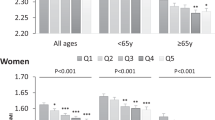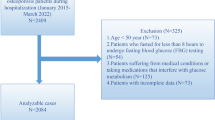Abstract
Objective:
To study the relationships of molecularly defined lactose malabsorption (LM) and self-reported lactose intolerance (LI) to bone mineral density (BMD) and fractures among Finnish postmenopausal women.
Design:
A cross-sectional study of two cohorts.
Setting:
Helsinki University Central Hospital.
Subjects:
One cohort was population-based and comprised 453 women, aged 62–78 (mean 69) y. Another comprised 52 women, aged 69–85 (mean 75) y, with osteoporotic fractures and 59 control women, aged 69–83 (mean 74) y, without osteoporosis.
Methods:
A single nucleotide polymorphism of the lactase (LCT) gene at chromosome 2q21–22 was studied. It shows complete association with intestinal disaccharidase activity, with the genotype CC−13 910 meaning adult-type hypolactasia (primary LM) and the genotypes CT−13 910 and TT−13 910 lactose absorption. BMD of the heel was measured by dual-energy X-ray absorptiometry (DXA).
Results:
In the population-based cohort, 16.0% of women had self-reported LI but only 15.3% of them had the CC−13 910 genotype. Calcium intake from dairy products (P=0.10) and BMD, adjusted for age, weight, height, exercise, smoking, and estrogen use (P=0.71) were similar for the genotypes. Women with self-reported LI had reduced calcium intake from dairy products (P<0.0001) but they were more frequent users of calcium supplements than lactose-tolerants (P<0.0001). Adjusted BMD was similar for lactose intolerant and tolerant women (P=0.60). Of 104 women with previous fracture in the population-based cohort, 13.5% had the CC−13 910 genotype, which did not differ from the prevalence of 19.3% among 347 women without fractures (P=0.29). The frequency of the CC−13 910 genotype (23.1%) for 52 women with established osteoporosis was similar as for 59 control women (15.3%) (P=0.19).
Conclusion:
Molecularly defined LM and self-reported LI are not risk factors for osteoporosis, if calcium intake from diet and/or supplements remains sufficient. Our study confirms the poor correlation between self-reported LI and LM established by different techniques.
Sponsorhip:
Supported by the Research Funding from Helsinki University Central Hospital (Erityisvaltionosuus) and by the Miina Sillanpää Foundation, Helsinki, Finland.
This is a preview of subscription content, access via your institution
Access options
Subscribe to this journal
Receive 12 print issues and online access
$259.00 per year
only $21.58 per issue
Buy this article
- Purchase on Springer Link
- Instant access to full article PDF
Prices may be subject to local taxes which are calculated during checkout
Similar content being viewed by others
References
Birge Jr SJ, Keutmann HT, Cuatrecasas P & Whedon GD (1967): Osteoporosis, intestinal lactase deficiency and low dietary calcium intake. N. Engl. J. Med. 276, 445–448.
Black RE, Williams SM, Jones IE & Goulding A (2002): Children who avoid drinking cow milk have low dietary calcium intakes and poor bone health. Am. J. Clin. Nutr. 76, 675–680.
Buning C, Schmidt H, Lochs H & Ockenga J (2004): Genetic components of lactose intolerance and community frequency. J. Bone Miner. Res. 19, 1746.
Carroccio A, Montalto G, Cavera G, Notarbatolo A & The Lactase Deficiency Study Group (1998): Lactose intolerance and self-reported milk intolerance: relationship with lactose maldigestion and nutrient intake. J. Am. Coll. Nutr. 17, 631–636.
Cochet B, Jung A, Griessen M, Bartholdi P, Schaller P & Donath A (1983): Effects of lactose on intestinal calcium absorption in normal and lactase-deficient subjects. Gastroenterology 84, 935–940.
Corazza GR, Benati G, Di Sario A, Tarozzi C, Strocchi A, Passeri M & Gasbarrini G (1995): Lactose intolerance and bone mass in postmenopausal Italian women. Br. J. Nutr. 73, 479–487.
Dawson-Hughes B, Dallal GE, Krall EA, Sadowski L, Sahyoun N & Tannenbaum S (1990): A controlled trial of the effect of calcium supplementation on bone density in postmenopausal women. N. Engl. J. Med. 323, 878–883.
de Vrese M, Stegelmann A, Richter B, Fenselau S, Laue C & Schrezenmeir J (2001): Probiotics-compensation for lactase insufficiency. Am. J. Clin. Nutr. 73 (Suppl. 2), 421.
Debongnie JC, Newcomer AD, McGill DB & Phillips SF (1979): Absorption of nutrients in lactase deficiency. Dig. Dis. Sci. 24, 225–231.
Delmas PD (2002): Treatment of osteoporosis. Lancet 359, 2018–2026.
Di Stefano M, Veneto G, Malservisi S, Cecchetti L, Minguzzi L, Strocchi A & Corazza GR (2002): Lactose malabsorption and intolerance and peak bone mass. Gastroenterology 122, 1793–1799.
Enattah N, Välimäki V-V, Välimäki MJ, Löyttyniemi E, Sahi T & Järvelä I (2004): Molecularly defined lactose malabsorption, peak bone mass and bone turnover rate in young Finnish men. Calcif. Tiss. Int. 75, 488–493.
Enattah NS, Sahi T, Savilahti E, Terwilliger JD, Peltonen L & Järvela I (2002): Identification of a variant associated with adult-type hypolactasia. Nat. Genet. 30, 233–237.
Finkenstedt G, Skrabal F, Gasser RW & Braunsteiner H (1986): Lactose absorption, milk consumption, and fasting blood glucose concentrations in women with idiopathic osteoporosis. BMJ 292, 161–162.
Fordham JN, Chinn DJ & Kumar N (2000): Identification of women with reduced bone density at the lumbar spine and femoral neck using BMD at the os calcis. Osteporos. Int. 11, 797–802.
Goulding A, Taylor RW, Keil D, Gold E, Lewis-Barned NJ & Williams SM (1999): Lactose malabsorption and rate of bone loss in older women. Age Ageing 28, 175–180.
Honkanen R, Kroger H, Alhava E, Turpeinen P, Tuppurainen M & Saarikoski S (1997): Lactose intolerance associated with fractures of weight-bearing bones in Finnish women aged 38-57 years. Bone 21, 473–477.
Honkanen R, Pulkkinen P, Jarvinen R, Kroger H, Lindstedt K, Tuppurainen M & Uusitupa M (1996): Does lactose intolerance predispose to low bone density? A population-based study of perimenopausal Finnish women. Bone 19, 23–28.
Kanis JA, Melton III LJ, Christiansen C, Johnston CC & Khaltaev N (1994): The diagnosis of osteoporosis. J. Bone. Miner. Res. 9, 1137–1141.
Kuokkanen M, Enattah NS, Oksanen A, Savilahti E, Orpana A & Jarvela I (2003): Transcriptional regulation of the lactase-phlorizin hydrolase gene by polymorphisms associated with adult type hypolactasia. Gut 52, 647–652.
Messer M & Dahlqvist A (1966): A one-step ultramicro method for the assay of intestinal disaccharidases. Anal. Biochem. 14, 376–392.
Miller PD, Siris ES, Barrett-Connor E, Faulkner KG, Wehren LE, Abbott TA, Chen Y-T, Berger ML, Santora AC & Sherwood LM (2002): Prediction of fracture risk in postmenopausal white women with peripheral bone densitometry: evidence from the national osteoporosis risk assessment. J. Bone Miner. Res. 17, 2222–2230.
Obermayer-Pietsch BM, Bonelli CM, Walter DE, Kuhn RJ, Fahrleitner-Pammer A, Berghold A, Goessler W, Stepan V, Dobnig H, Leb G & Renner W (2004): Genetic predisposition for adult lactose intolerance and relation to diet, bone density, and bone fractures. J. Bone Miner. Res. 19, 42–47.
Olds LC & Sibley E (2003): Lactase persistence DNA variant enhances lactase promoter activity in vitro: functional role as a cis regulatory element. Hum. Mol. Genet. 12, 2333–2340.
Sahi T, Isokoski M, Jussila J, Launiala K & Pyörälä K (1973): Recessive inheritance of adult-type lactose malabsorption. Lancet 2, 823–826.
Saltzman JR, Russell RM, Golner B, Barakat S, Dallal GE & Goldin BR (1999): A randomized trial of Lactobacillus acidophilus BG2FO4 to treat lactose intolerance. Am. J. Clin. Nutr. 69, 140–146.
Stallings VA, Oddleifson NW, Negrini BY, Zemel BS & Wellens R (1994): Bone mineral content and dietary calcium intake in children prescribed a low-lactose diet. J. Pediatr. Gastroenterol. Nutr. 18, 440–445.
Suarez FL, Savaiano DA & Levitt MD (1995): A comparison of symptoms after the consumption of milk or lactose-hydrolyzed milk by people with self-reported severe lactose intolerance. N. Engl. J. Med. 333, 1–4.
Syvänen AC, Sajantila A & Lukka M (1993): Identification of individuals by analysis of biallelic DNA markers, using PCR and solid-phase minisequencing. Am. J. Hum. Genet. 52, 46–59.
Tamm A (1994): Management of lactose intolerance. Scand. J. Gastroenterol. 202 (Suppl 1), 55–63.
Tremaine WJ, Newcomer AD, Riggs BL & McGill DB (1986): Calcium absorption from milk in lactase-deficient and lactase-sufficient adults. Dig. Dis. Sci. 31, 376–378.
Wheadon M, Goulding A, Barbezat GO & Campbell AJ (1991): Lactose malabsorption and calcium intake as risk factors for osteoporosis in elderly New Zealand women. NZ Med. J. 104, 417–419.
Author information
Authors and Affiliations
Corresponding author
Additional information
Guarantor: MJ Välimäki.
Contributors: All investigators contributed to the study design and writing of the paper. NE performed the genotyping. TP performed medical examinations and was responsible for data collection. MJV is the guarantor and finalized the manuscript. EL was responsible for statistical analyses. IJ was responsible for the DNA analyses and supervised the lab work.
Rights and permissions
About this article
Cite this article
Enattah, N., Pekkarinen, T., Välimäki, M. et al. Genetically defined adult-type hypolactasia and self-reported lactose intolerance as risk factors of osteoporosis in Finnish postmenopausal women. Eur J Clin Nutr 59, 1105–1111 (2005). https://doi.org/10.1038/sj.ejcn.1602219
Received:
Revised:
Accepted:
Published:
Issue Date:
DOI: https://doi.org/10.1038/sj.ejcn.1602219
Keywords
This article is cited by
-
Association of calcium intake, lactose intolerance and physical activity with bone health assessed via quantitative ultrasound among young adults of a Malaysian university
Archives of Osteoporosis (2021)
-
Adult lactose intolerance, calcium intake, bone metabolism and bone density in German-Turkish immigrants
Journal of Bone and Mineral Metabolism (2020)
-
Primary lactase deficiency and bone mineral density in postmenopausal women
Osteoporosis International (2019)
-
Does primary lactase deficiency reduce bone mineral density in postmenopausal women? A systematic review and meta-analysis
Osteoporosis International (2018)
-
Association of lactase 13910 C/T polymorphism with bone mineral density and fracture risk: a meta-analysis
Journal of Genetics (2017)



